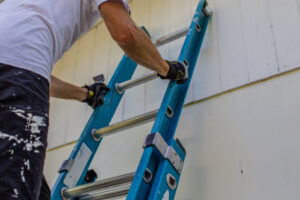The Occupational Safety and Health Administration (OSHA) announced June 4 that it has reached a settlement with Adidas America Inc., requiring the company to pay $235,000 in fines and implement enhanced safety measures at multiple facilities.
OSHA conducted a 2024 follow-up inspection at an Adidas warehouse in upstate New York. The agency initially cited the company for hazards in 2021 during an inspection that found missing guardrails and an unsafe ladder. When agency inspectors returned in 2024, they discovered that Adidas hadn’t corrected the hazards cited in 2021 and found an additional unsafe ladder violation.
The settlement agreement requires Adidas to implement enhanced abatement measures at its facilities in New York, New Jersey, and Puerto Rico that include adopting a comprehensive safety and health management program, retraining employees on fall hazards, assessing and auditing potential fall hazards at each facility, and discontinuing the use of overhead storage in its facilities.
Adidas America Inc. is a subsidiary of Adidas AG, an athletic apparel and footwear company headquartered in Herzogenaurach, Bavaria, Germany.
CSB issues report on fatal 2024 plant explosion
On June 3, the U.S. Chemical Safety and Hazard Investigation Board (CSB) issued a final report on the fatal explosion and eruption at the Techniques Surfaces USA (TS USA) liquid nitriding facility in Chattanooga, Tennessee, that fatally injured an employee on May 30, 2024. The incident also resulted in multiple fires and over $1 million in property damage.
The TS USA facility was shut down for approximately eight months.
TS USA is a subsidiary of the French company HEF Groupe that treats metal parts in a liquid nitriding process, which involves a reaction that hardens the metal’s surface. On May 30, five hollow rollers were submerged into molten salt baths used in the nitriding process. Each roller was a large cylinder with an empty cavity and drain holes on the top and bottom, according to the CSB.
When the rollers were submerged in the baths, molten salt entered the cavities through the drain holes. Due to the small size of the drain holes, when the rollers were lifted out of the salt bath, the salt was unable to fully drain from one of the rollers, which created a thick, solidified plug at the bottom of the roller.
All five rollers were submerged in a hot water rinse bath to remove residual salt, but when the rollers were lifted out of the water, the salt plug prevented water from draining out of the plugged roller.
Trying to troubleshoot the plugged roller, TS USA employees reintroduced all five rollers back into the salt bath to try to melt the solidified salt in the plugged roller to drain salt out of the roller.
The employees didn’t realize there was also water in the cavity of the plugged roller, according to the CSB. When the roller with the retained water was inserted into the 800°F salt bath, it began heating up. The boiling water inside the roller increased the pressure inside the roller’s cavity, releasing steam that caused the hot molten salt to erupt from the bath and engulf one of the TS USA employees.
The employee suffered second- and third-degree chemical and thermal burns over 95 percent of his body. He was transported to a nearby hospital, where he died later that day. Three other TS USA employees suffered minor burns and were treated on-site.
“This terrible incident underscores how critically important it is for facilities like TS USA to have a comprehensive and effective safety management system in place,” CSB Chairperson Steve Owens said in a statement.
The CSB’s report includes a total of seven recommendations to TS USA and HEF Groupe.
The CSB is an independent federal government board that investigates industrial chemical incidents. It doesn’t issue citations for regulatory violations or impose any fines. Instead, the board makes safety recommendations to companies, industry groups, labor unions, and regulatory agencies, including the Environmental Protection Agency (EPA) and OSHA.

